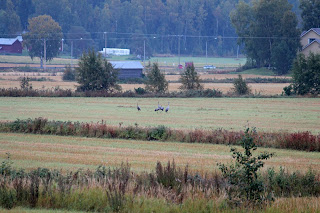This summer I have purchased a few books. Some of you may know I worked as a librarian for forty years. Books are an essential part of my life. Even if I read lots of e-books and listen to audiobooks nowadays, I still want printed books also. To touch and feel a book is a great pleasure and a very tactile sensation.
"Keskiajan puvut" (Medieval dress) by Satu Hovi, Hannele Maahinen and Katri Niemi is a book I've wanted to have for years, if not decades, but never thought anyone would write. The book is a thorough guide for making you own medieval dress, for child, woman, and man. Tunics, gowns, dresses, nalbinded mittens, shoes, bands and cords, embroidery, details in the dress. I can't wait to find fabrics so I can start sewing!
Easy to copy patterns, and good photos. This one shows the typical bronze embroidery used in the medieval Finnish dress:
It was often used in hems, where it adds weight so the dress is easier to wear. We all know the Marilyn Monroe effect, don't we?
I have also bought a book I've been looking into for very long: "Ur textilkonstens historia" by Agnes Geijer. It's a thorough history of textile in the Western world since ancient times. I'm especially happy about the weaving section, as that is a field I know almost nothing about.
The book has been translated to English, "A History of Textile Art". The illustrations are typical for the time the first printing was published in 1972: adequate and clear, with many drawings. The printing from 2006 which I now own also has color photos. The pictures below foresee something that's coming into my life very soon:
Kasper likes books, here he's reading Elizabeth Wayland Barber's "Women's Work. The first 20.000 years". He was very interested in the picture of a woman spinning on a drop spindle, I couldn't make him move so I could take a photo. Sometimes I think he knows what he sees, because this is not the first time he's been looking at pictures of spindling women.
I also have Barber's "Prehistoric Textiles", that I like very much. "Women's Work" is an archaeological and sociological study of women's work with producing textiles, starting 20.000 years ago and ending in Classic Greece. The thoughts such a study gives you are overwhelming. So much work, so much struggle, and all done while taking care of your family and your house. It makes you shiver. My motto, "Not one day without thread", comes from reading books and studies like this one. The book is full of wonderful examples of how textiles have been made, and of the conditions during which the women worked.
Please give a thought to the women and children in the textile factories in India, China, Pakistan, and other countries where all the cheap clothes are made in our days.
And look here! Deborah Robson's and Carol Ekarius' "The Field Guide to Fleece"! This little book is a shorter version of "The Fleece & Fiber Source Book". It's meant to be exactly what it says, a field guide. Small enough to take along to fiber festivals, and sturdy enough to be thrown into your back pack together with cameras, phones, snacks, knittings, drink bottles, and spindles. The book is bound, and glued strongly enough to for rough handling (= you can open it without fearing it'll fall into pieces!) The paper is glossy, of a thick high quality, so you can't very easily tore it.
The text is of the kind we've been spoiled with from FFSB: interesting, informative, easy to read. For each breed the authors give suggestions for use, and they also tell how the wool takes dyes. The order is alphabetical, so it's easy to find what you're looking for. The photos make you want to purchase the wools immediately, and start spinning. Here's one Deb's favorite wools:
The book loving dog and the new books about textile:
Oh yes, two more books coming my way this autumn :) Kasper may have a look at them also.































